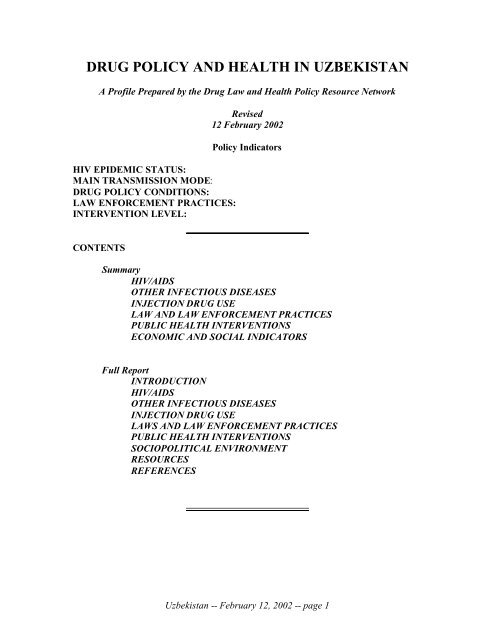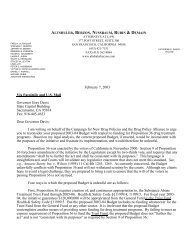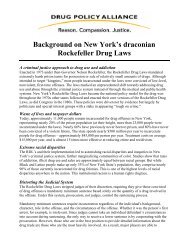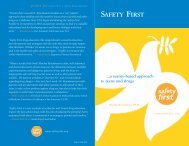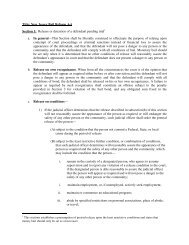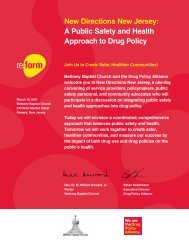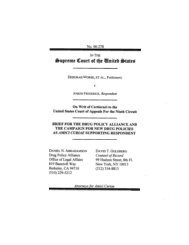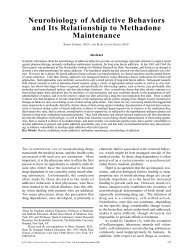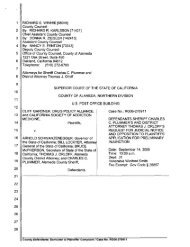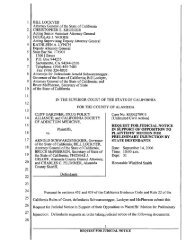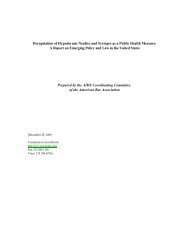Drug Policy and Health In Uzbekistan - Drug Policy Alliance
Drug Policy and Health In Uzbekistan - Drug Policy Alliance
Drug Policy and Health In Uzbekistan - Drug Policy Alliance
You also want an ePaper? Increase the reach of your titles
YUMPU automatically turns print PDFs into web optimized ePapers that Google loves.
DRUG POLICY AND HEALTH IN UZBEKISTAN<br />
A Profile Prepared by the <strong>Drug</strong> Law <strong>and</strong> <strong>Health</strong> <strong>Policy</strong> Resource Network<br />
HIV EPIDEMIC STATUS:<br />
MAIN TRANSMISSION MODE:<br />
DRUG POLICY CONDITIONS:<br />
LAW ENFORCEMENT PRACTICES:<br />
INTERVENTION LEVEL:<br />
Revised<br />
12 February 2002<br />
<strong>Policy</strong> <strong>In</strong>dicators<br />
CONTENTS<br />
Summary<br />
HIV/AIDS<br />
OTHER INFECTIOUS DISEASES<br />
INJECTION DRUG USE<br />
LAW AND LAW ENFORCEMENT PRACTICES<br />
PUBLIC HEALTH INTERVENTIONS<br />
ECONOMIC AND SOCIAL INDICATORS<br />
Full Report<br />
INTRODUCTION<br />
HIV/AIDS<br />
OTHER INFECTIOUS DISEASES<br />
INJECTION DRUG USE<br />
LAWS AND LAW ENFORCEMENT PRACTICES<br />
PUBLIC HEALTH INTERVENTIONS<br />
SOCIOPOLITICAL ENVIRONMENT<br />
RESOURCES<br />
REFERENCES<br />
<strong>Uzbekistan</strong> -- February 12, 2002 -- page 1
Summary<br />
I. HIV/AIDS<br />
Although data are incomplete, <strong>Uzbekistan</strong> is apparently experiencing a dramatic<br />
but locally concentrated increase in HIV cases. The epicenters of the epidemic are the<br />
capital city of Tashkent <strong>and</strong> the city of Yangiyol. The actual number of HIV cases<br />
reported in <strong>Uzbekistan</strong> is small. However, experts fear that those numbers will increase.<br />
<strong>Uzbekistan</strong> sits on major drug trafficking route, placing it at risk of a growing IDU<br />
population. Also, the annual rate of newly diagnosed HIV infections increased from 0.1<br />
per million population in 1998 to 6.4 per 1 per million in 2000, a 5.5 fold increase over<br />
1999. UNAIDS personnel have estimated an 80% HIV prevalence rate among injection<br />
drug users. (6)(17)<br />
HIV Cases by Mode of Transmission,<br />
2000<br />
9%<br />
4%<br />
Hetero<br />
IDU<br />
Other<br />
87%<br />
Source: (11)<br />
New HIV <strong>In</strong>fections per Million<br />
Population<br />
8<br />
6<br />
4<br />
2<br />
0<br />
1997 1998 1999 2000<br />
Source: (11)<br />
<strong>Uzbekistan</strong> -- February 12, 2002 -- page 2
II.<br />
OTHER INFECTIOUS DISEASES<br />
Cases per 100,000 Population<br />
80<br />
70<br />
60<br />
50<br />
40<br />
30<br />
20<br />
10<br />
0<br />
1993<br />
1994<br />
1995<br />
1996<br />
1997<br />
1998<br />
1999<br />
Syphilis<br />
TB<br />
Sources: (12) (13)<br />
III.<br />
INJECTION DRUG USE<br />
<strong>Drug</strong> Use. <strong>Drug</strong> use <strong>and</strong> addiction are increasing, thanks to increased opium production<br />
in Afghanistan. During 2000, new epidemics in drug injectors emerged in <strong>Uzbekistan</strong>.<br />
Most experts say there are about 20,000 drug-dependent people in <strong>Uzbekistan</strong>. (3)<br />
However, some sources place that number as high as 44,000. (23)<br />
Risk Behavior. There are particularly problems in the prison <strong>and</strong> sex worker<br />
population. <strong>Drug</strong>s are available in prison <strong>and</strong> reuse of contaminated injection equipment<br />
is common. (13)<br />
IV.<br />
LAW AND LAW ENFORCEMENT PRACTICES<br />
Law Enforcement in <strong>Uzbekistan</strong> considers the drug trade to be a top concern.<br />
However, they place their focus on stopping drug trafficking rather than on helping those<br />
addicted to drugs. There are harsh penalties for dealing drugs, such as the possibility of<br />
receiving the death penalty. Human Rights Groups report that law enforcement in<br />
<strong>Uzbekistan</strong> often plants drugs on people of certain ethnic <strong>and</strong> religious groups.<br />
Authorities often force people to pay bribes under the pretext of policing narcotics. The<br />
United Nation’s Office of <strong>Drug</strong> Control <strong>and</strong> Crime Prevention sponsors <strong>Uzbekistan</strong>’s<br />
main narcotics control program. It focuses on the development of a fungus capable of<br />
destroying the opium crop at its root. (7) (17) (24)<br />
<strong>Uzbekistan</strong> -- February 12, 2002 -- page 3
Law on the Books<br />
No law prohibits syringe purchase or<br />
possession, or the operation of syringe<br />
exchange programs.<br />
A new law took effect on January 1, 2002.<br />
It sets a framework for regulating<br />
production, use <strong>and</strong> transport of narcotics.<br />
Critics say the law lacks details.<br />
Registered addicts are subject to<br />
compulsory treatment.<br />
The accused has a right to counsel. They<br />
may hire counsel or use one appointed to<br />
them. They have the right to attend<br />
proceedings, confront witnesses <strong>and</strong><br />
present evidence. There is no bail. If the<br />
accused is deemed not to be violent they<br />
are released, but must sign a pledge not to<br />
leave the city. Search warrants are required.<br />
Actual practice<br />
Possession of a syringe exposes an IDU to<br />
potential police intervention by indicating<br />
drug possession. This practice is likely to<br />
discourage drug users from carrying or<br />
possessing sterile injection equipment.<br />
Anti-drug efforts are believed to target<br />
particular ethnic <strong>and</strong> religious groups.<br />
Also, many officials force people to pay<br />
enormous bribes, under the pretext of<br />
stopping narcotics trafficking.<br />
Many defense lawyers are not skilled.<br />
Also, courts to not often allow all defense<br />
witnesses to be heard. <strong>In</strong> some political<br />
cases, the defendants have not had counsel.<br />
V. PUBLIC HEALTH INTERVENTIONS<br />
The government of <strong>Uzbekistan</strong> has recognized that narcotics are important<br />
security concern. However, the government’s efforts are focused on stopping the<br />
narcotics trade, not on harm reduction. The Ministry of <strong>Health</strong> has set up seven substance<br />
abuse rehabilitation clinics in the country. Also, the Open Society <strong>In</strong>stitute funds one<br />
harm reduction program, The Tashkent City Women’s <strong>and</strong> Children’s Center, which<br />
works primarily with commercial sex users. It works to reduce drug use among this<br />
group. It also distributes condoms <strong>and</strong> is setting up a hotline. (22) (23)<br />
<strong>Drug</strong> Treatment. Registered addicts are subject to compulsory treatment.<br />
Syringe exchange programs are not illegal. However, possession of syringes may expose<br />
a person to the police by indicating drug possession. We were unable to determine the<br />
legality of opium substitution therapy. (6) (7)<br />
VI.<br />
ECONOMIC AND SOCIAL INDICATORS<br />
The Transparency Corruption Perceptions <strong>In</strong>dex (CPI) ranks countries in terms of<br />
the degree to which corruption is perceived to exist among public officials <strong>and</strong><br />
politicians. <strong>In</strong> 2001, <strong>Uzbekistan</strong> was ranked 71 of 91 countries, with a score of 2.7 of a<br />
possible 10.<br />
<strong>Uzbekistan</strong> -- February 12, 2002 -- page 4
The Human Development <strong>In</strong>dex value is a composite index measuring average<br />
achievement in three basic dimensions of human development-a long <strong>and</strong> healthy life,<br />
knowledge <strong>and</strong> a decent st<strong>and</strong>ard of living. <strong>In</strong> 1999, <strong>Uzbekistan</strong> ranked 99 of the 174<br />
countries measured.<br />
The GINI index measures the extent to which the distribution of income (or in some<br />
cases consumption expenditures) among individuals or households within an economy<br />
deviates from a perfectly equal distribution. The GINI index of zero equals perfect<br />
equality, while <strong>and</strong> index of 100 implies perfect inequality. The GINI index for the most<br />
recent reported year for <strong>Uzbekistan</strong> was 33.3 in 1996.<br />
Unemployment refers to the share of the labor force without work but available<br />
for <strong>and</strong> seeking employment. Definitions of labor force <strong>and</strong> unemployment differ by<br />
country. <strong>Uzbekistan</strong>’s unemployment rate saw a sharp rise from 1995 at 0.4% to 5% in<br />
1998.<br />
The Gross Domestic Product (GDP) is the total of all economic activity in one<br />
country, regardless of who owns the productive assets. There has been a precipitous<br />
decline in GDP in <strong>Uzbekistan</strong> during the past decade. <strong>In</strong> 1990, the GDP was $40,304<br />
Million (US) <strong>and</strong> in 1999 it declined to $15,842. The average annual growth of the<br />
economy from 1990 to 1999 was –3.1%.<br />
<strong>Uzbekistan</strong> -- February 12, 2002 -- page 5
DRUG POLICY AND HEALTH IN UZBEKISTAN<br />
A Profile Prepared by the <strong>Drug</strong> Law <strong>and</strong> <strong>Health</strong> <strong>Policy</strong> Resource Network<br />
Full Report<br />
I. INTRODUCTION<br />
The <strong>Drug</strong> Law <strong>and</strong> <strong>Health</strong> <strong>Policy</strong> Resource Network is an international research<br />
collaboration designed to improve data collection <strong>and</strong> policy analysis on drug policy <strong>and</strong><br />
health in the countries of Eastern Europe <strong>and</strong> the Former Soviet Union. The information<br />
in this report was gathered by staff at Temple University’s Beasley School of Law <strong>and</strong><br />
the University of Connecticut <strong>Health</strong> Sciences Center. It will be augmented by further<br />
research in 2002 by network collaborators in the study region.<br />
This Report presents available information in six domains: HIV/AIDS, other<br />
infectious diseases, injection drug use, law <strong>and</strong> law enforcement practices, public health<br />
interventions, <strong>and</strong> economic <strong>and</strong> social indicators. It concludes that <strong>Uzbekistan</strong> is in the<br />
early stages of a serious HIV epidemic driven by injection drug use. With sufficient<br />
external support <strong>and</strong> dramatic internal changes in drug policy <strong>and</strong> law enforcement<br />
practice, a public health effort against HIV <strong>and</strong> other blood-borne diseases could be<br />
successful.<br />
II.<br />
HIV/AIDS<br />
Accurate <strong>and</strong> complete data on HIV in <strong>Uzbekistan</strong> are not available. The data<br />
presented here are from a variety of sources <strong>and</strong> may not entirely agree. These data<br />
generally do not represent HIV incidence, <strong>and</strong> depend heavily upon patterns of HIV<br />
testing <strong>and</strong> reporting that remain very incomplete in the most severely affected countries.<br />
HIV infection is defined as an individual with HIV infection confirmed by a laboratory<br />
according to country definitions <strong>and</strong> requirements. AIDS cases are reported according to<br />
a uniform AIDS case definition originally published in 1982 <strong>and</strong> revised in 1985, 1987<br />
<strong>and</strong> for adults <strong>and</strong> adolescents (age >13) in 1993. The 1993 European AIDS surveillance<br />
case definition differs from that used in the United States in that it does not include CD4<br />
lymphocyte criteria.<br />
Overall Data. The annual rate of newly diagnosed HIV infections increased from<br />
0.1 per million population in 1998 to 6.4 per 1 per million in 2000, a 5.5 fold increase<br />
over 1999. (1) There is an estimated prevalence of < 100 cases in the adult population<br />
(age 15-49) <strong>and</strong> < 100 among children. (11) (13)<br />
<strong>Uzbekistan</strong> -- February 12, 2002 -- page 6
Data from The European Center for the Epidemiological Monitoring of AIDS (11)<br />
Year<br />
Reported<br />
AIDS cases<br />
Reported<br />
New HIV<br />
infections<br />
# Rate/<br />
Homo/bi<br />
Contact<br />
#<br />
<strong>In</strong>jection<br />
<strong>Drug</strong> Use<br />
#<br />
Heterosexual<br />
Contact<br />
#<br />
Perinatal<br />
Transmission<br />
#<br />
# Rate/<br />
HIV AIDS HIV AIDS HIV AIDS HIV AIDS<br />
Million Million<br />
1993 1 0.0 - - - - - - - - - -<br />
1994 0 0.0 - - - - - - - - - -<br />
1995 0 0.0 - - - - - - - - - -<br />
1996 2 0.1 - - 0 0 0 0 0 2 0 0<br />
1997 1 0.0 7 0.3 0 1 0 0 3 0 0 0<br />
1998 2 0.1 3 0.1 0 0 1 0 2 2 0 0<br />
1999 1 0.0 28 1.2 1 0 15 1 5 0 0 0<br />
2000 3 0.1 154 6.4 0 0 134 1 6 1 0 0<br />
Additional demographics. The overall population of the country is 24,755,519.<br />
The population breaks down among many ethnicities. Uzbeks take up 71%, Russians 8%,<br />
Tajiks 5%, Kazakhs 4% <strong>and</strong> Tartars 3%. Also mixed in are Ukrainians, Armenians,<br />
Azerbaijani, Turkmen, Kyrgyzstani, Jews <strong>and</strong> Germans. The predominant religion is<br />
Sunni Muslim. (4) The HIV/AIDS adult (age 15-49) prevalence rate at the end of 1999<br />
was less than .01 per 100,000 population. There were virtually no cases of HIV reported<br />
among homosexuals. The rate of AIDS cases diagnosed among IDU’s for 2000 per 1<br />
million population was 0.04. The rate of HIV cases diagnosed among IDU’s for 1 million<br />
population was 6.0. For heterosexuals, the rate of AIDS cases diagnosed for 2000 per 1<br />
million population was 0.04. The number of HIV diagnosed cases for this population was<br />
0.3 (11)<br />
Regional distribution. The majority of HIV/AIDS cases have occurred in<br />
the capital city of Tashkent <strong>and</strong> the city of Yangiyol. According to <strong>In</strong>tercountry<br />
programme advisor for UNAIDS Rudick Adamian, there is an eighty percent prevalence<br />
of HIV among injection drug users. (6) Tashkent sits along a major drug trafficking<br />
route. The BBC has referred it to as “heroin country”. (17)<br />
Risk Behavior. According to <strong>In</strong>ternational Harm Reduction Development<br />
Program (IHRD), ignorance of the risks of HIV <strong>and</strong> other STIs is relatively high in<br />
<strong>Uzbekistan</strong>. Those at greatest risk—commercial sex workers—are not necessarily better<br />
informed than the general public. Many commercial sex workers engage in high-risk<br />
behavior, such as drug use <strong>and</strong> having unprotected sex. (22)<br />
Stigma <strong>and</strong> Social Attitudes toward HIV/AIDS <strong>and</strong> Risk Behavior. There<br />
appears to be considerable reluctance throughout the society to deal with the threat of<br />
HIV. Surveys indicate that few of the estimated 5,000 sex workers in Tashkent have ever<br />
had an HIV test even after other STIs have been confirmed. (22) Also, many religious<br />
leaders remain sensitive over HIV/AIDS harm reduction projects. Most ordinary citizens<br />
share their sentiments. Many media campaigns have met significant resistance from the<br />
public, especially those with explicit references to sex. "<strong>In</strong> most towns of the Ferghana<br />
Valley, sensitivity about practices connected with sex is traditionally high," said Yusup<br />
<strong>Uzbekistan</strong> -- February 12, 2002 -- page 7
Tavakilov, a journalist based in the Uzbek city of Andijan. "<strong>In</strong> many families, while<br />
watching the TV, if there is a porno scene, or anything that implies sex, they will switch<br />
to another channel. Otherwise, it creates embarrassment for family members." (9) It is<br />
especially hard to reach the homosexual population. "I constantly am very afraid for my<br />
life because my community hates homosexuals, <strong>and</strong> police persecution is very brutal<br />
here," said Tolibjon, a homosexual who lives in Margelan, a small town in the Uzbek<br />
sector of the Ferghana Valley. (18) The Feghana Valley stretches across parts of<br />
Tajikistan, Kyrgyzstan <strong>and</strong> <strong>Uzbekistan</strong>. <strong>Uzbekistan</strong> controls most of the valley. The<br />
valley, especially the Uzbek part, is one of the major centers of Islam in central Asia. So<br />
much so that it led the Islamic resistance to Soviet Power. There has been a huge revival<br />
of Islamic fundamentalism in this valley. (5)<br />
III. OTHER INFECTIOUS DISEASES<br />
The spread of HIV is related in important ways to the incidence of other<br />
infectious diseases. Us of injection drugs <strong>and</strong> non-sterile injection equipment are risk<br />
factors not only for HIV, but also Hepatitis. <strong>In</strong>carceration in many countries in this<br />
region is a risk factor for tuberculosis. Sexually transmitted diseases may increase the<br />
likelihood of HIV transmission during sex.<br />
Summary of Situation. <strong>Uzbekistan</strong> appears to be in the midst of growing<br />
epidemics of TB <strong>and</strong> syphilis.<br />
Data from (12) (13)<br />
Year TB Syphilis<br />
# Rate/<br />
100,000<br />
(?)<br />
Rate/<br />
100,000<br />
Hepatitis Hepatitis Hepatitis<br />
A B C<br />
# # #<br />
1993 9774 44.7 8 - - -<br />
1994 14,890 66.7 12 - - -<br />
1995 9866 43.3 25 - - -<br />
1996 11,919 51.4 23 - - -<br />
1997 13,352 56.4 44 - - -<br />
1998 14,558 60.4 - 49,345 - 135<br />
1999 15,080 63 - - - -<br />
2000 - - - - - -<br />
IV. INJECTION DRUG USE<br />
This section reports available information about drug use levels, trends <strong>and</strong> risk<br />
behaviors, as well as social attitudes about drug use <strong>and</strong> information about the problem of<br />
drug overdose. <strong>Drug</strong> treatment <strong>and</strong> other interventions to reduce the morbidity <strong>and</strong><br />
mortality of drug use are discussed in section V, below. Data about drug use come<br />
primarily from unofficial sources, including more or less rigorous rapid assessments,<br />
consultant reports <strong>and</strong> the news media.<br />
<strong>Uzbekistan</strong> -- February 12, 2002 -- page 8
Summary of Situation. <strong>Drug</strong> abuse <strong>and</strong> addiction is increasing. There is a<br />
dramatic increase in the use of heroin, opium <strong>and</strong> hashish. Explosive growth of heroin<br />
<strong>and</strong> opium production in Afghanistan has led to a dramatic increase in the amount of<br />
heroin <strong>and</strong> opium available in the country. (6) Most experts say there are approximately<br />
20,000 people addicted to drugs in <strong>Uzbekistan</strong>. <strong>In</strong> 1998 the government, with UNDCP<br />
assistance, commissioned a study to get a more precise picture of dem<strong>and</strong> in the country.<br />
Despite awareness of the problem, however, the government has instituted no dem<strong>and</strong><br />
reduction programs. The 15,000 registered addicts are, however, subject to compulsory<br />
treatment. (7) Some experts believe that the actual number of addicts could be 44,000.<br />
(23)<br />
<strong>Drug</strong> Traffic. Effective government eradication programs have eliminated nearly<br />
all illicit production of opium poppies in <strong>Uzbekistan</strong>. However, the amount of drugs<br />
crossing <strong>Uzbekistan</strong> is growing, because of its location on a major drug route <strong>and</strong><br />
because <strong>Uzbekistan</strong>’s roads <strong>and</strong> air service are in relatively good shape. Opium <strong>and</strong><br />
cannabis products originating in southwest Asia <strong>and</strong> bound for Russia <strong>and</strong> Europe take<br />
several routes across Uzbek territory. The only Afghan-Uzbek border crossing is closed,<br />
so most drugs come into <strong>Uzbekistan</strong> via Tajikistan. One major route--via the Gorno-<br />
Badakshan region of Tajikistan, through Osh in Kyrgyzstan, <strong>and</strong> into <strong>Uzbekistan</strong>'s<br />
Ferghana Valley—has been seeing less traffic. <strong>In</strong>stead, smugglers are crossing the Tajik-<br />
Uzbek border near Khoj<strong>and</strong> into the Syrdarya Oblast, <strong>and</strong> further south into the<br />
Surkh<strong>and</strong>arya Oblast. <strong>Drug</strong> smugglers are regularly caught on the Dushanbe-Moscow<br />
train. Some cannabis <strong>and</strong> opium poppies are cultivated in the mountainous areas of<br />
<strong>Uzbekistan</strong>, particularly in the regions of Samark<strong>and</strong> <strong>and</strong> Syrh<strong>and</strong>arya. However, the<br />
amount growing there has been decreasing, due to Uzbek eradication efforts. (7)<br />
V. LAWS AND LAW ENFORCEMENT PRACTICES<br />
A. <strong>Drug</strong> Use Related - Law<br />
This section describes what is known about both the drug-related laws on the<br />
books <strong>and</strong> the way these laws are enforced. The section covers syringe access, drug<br />
possession, drug treatment, drug trafficking, <strong>and</strong> the h<strong>and</strong>ling of drug arrestees <strong>and</strong><br />
prisoners within the criminal justice system. It also lists the international drug-related<br />
instruments to which the country is a signatory.<br />
Syringe Access/Needle Exchange – Law. No law prohibits syringe purchase or<br />
possession, or the operation of syringe exchange programs . (6)<br />
Syringe Access/ Needle Exchange – Practices. Possession of a syringe exposes<br />
an IDU to potential police intervention by indicating drug possession. This practice is<br />
likely to discourage drug users from carrying or possessing sterile injection equipment.<br />
(6)<br />
<strong>Drug</strong> Possession – Law. According to the U.S. State Department, <strong>Uzbekistan</strong> has<br />
enacted a new comprehensive drug control law:<br />
<strong>Uzbekistan</strong> -- February 12, 2002 -- page 9
The law sets out a legal framework for the regulation of production, use<br />
<strong>and</strong> transport of narcotics <strong>and</strong> precursors. Licensing is now required for all<br />
legitimate activities, including medical use, of these substances. <strong>In</strong><br />
addition, import <strong>and</strong> export activities require explicit permission of the<br />
State Commission on <strong>Drug</strong> Control. The law also contains a section on<br />
combating illegal trafficking in narcotics, directing the State Commission<br />
on <strong>Drug</strong> Control to coordinate counternarcotics efforts <strong>and</strong> authorizing<br />
law enforcement agencies to take such measures as conducting searches,<br />
confiscating contrab<strong>and</strong> <strong>and</strong> compelling blood testing for suspected<br />
criminal drug use. The law's final section guarantees medical treatment for<br />
addicts. Although the law's scope is comprehensive, it is not detailed.<br />
Officials are currently drafting the regulations necessary to implement the<br />
law. (7)<br />
<strong>Drug</strong> Possession – Practices. As reported by Eurasianet, Anti-drug efforts are<br />
believed by human rights groups to target particular ethnic <strong>and</strong> religious groups. Also,<br />
many officials force people to pay enormous bribes, under the pretext of stopping<br />
narcotics trafficking. As a rice trader from Batken put it, "The Uzbek police start<br />
searching us… They say they are looking for drugs… I know several Kyrgyz<br />
businessmen who have been relieved of their goods as well as large sums of money. Of<br />
course they didn't try to complain because everyone knows that if you end up in an<br />
Uzbek prison, you'll probably never get out." <strong>Uzbekistan</strong>’s main counter-narcotic efforts<br />
centers around destroying the illicit crop cultivation. The efforts are sponsored by the<br />
UN's Office of <strong>Drug</strong> Control <strong>and</strong> Crime Prevention (UN ODCCP). The UN ODCCP is<br />
supporting research at <strong>Uzbekistan</strong>'s <strong>In</strong>stitute of Genetics on the development of a fungus<br />
capable of destroying the opium crop at its root. The fungus was first discovered at a<br />
former Soviet biological warfare plant in <strong>Uzbekistan</strong>, originally designed to destroy<br />
NATO’s food supplies. (7) (17)<br />
Compulsory Treatment Practices. Registered addicts are subject to compulsory<br />
treatment. (7)<br />
<strong>Drug</strong> Trafficking – Practices. Criminal penalties for dealing drugs are quite<br />
severe. <strong>In</strong> 1995, a new criminal code was implemented. It includes the possibility of the<br />
death penalty for drug dealers <strong>and</strong> tougher penalties for drug-related crimes all around.<br />
(23)<br />
<strong>Drug</strong> Treatment – Regulation. The legality of opium substitution therapy, such<br />
as methadone <strong>and</strong> Buprenorphine, is unknown.<br />
Criminal Justice System – Law. <strong>Uzbekistan</strong> uses the Soviet judicial system.<br />
This involves a trial by a paned of three judges. One of the judges is a professional judge<br />
<strong>and</strong> the other two are chosen by the workers’ collectives to serve for 2 ½ years. The<br />
<strong>Uzbekistan</strong> -- February 12, 2002 -- page 10
accused has a right to counsel. They may hire counsel or use one appointed to them.<br />
Those accused have the right to attend proceedings, confront witnesses <strong>and</strong> present<br />
evidence. There is no bail. If the accused is deemed not to be violent they are released,<br />
but must sign a pledge not to leave the city. Search warrants are required. (16)<br />
Criminal Justice System – Practices. <strong>In</strong> practice many defense lawyers are not<br />
skilled. Also, courts to not often allow all defense witnesses to be heard. <strong>In</strong> some political<br />
cases, the defendants have not had counsel. Written documents such as confessions are<br />
given more weight than witnesses. There is not judicial review of search warrants issued<br />
by a procurator. There are not warrants for phone tapping, so security agencies often use<br />
phone <strong>and</strong> wire-tapping. The death penalty is subject to much criticism, partly because its<br />
implementation is secret. <strong>Uzbekistan</strong> refuses to release statistics on the death penalty.<br />
(16) <strong>Drug</strong>s are available in prison <strong>and</strong> needle <strong>and</strong> syringe sharing tends to be common.<br />
Clean needles, syringes <strong>and</strong> disinfectants are rarely available. However, known HIVinfected<br />
prisoners are isolated from other inmates. (13) Prisons are overcrowded. The 73<br />
penal institutions are designed to hold between 1,500 <strong>and</strong> 2,000 prisoners, but currently<br />
hold about 4,000. According to Human Rights Society of <strong>Uzbekistan</strong>, several<br />
concentration camps have been built to hold those sentenced for religious activities. One<br />
such facility, near Zhaslyk holds 15,000. This group says the official “prison” population<br />
is somewhere around 63,000. (19)<br />
<strong>In</strong>ternational <strong>Drug</strong> Conventions or agreements to which <strong>Uzbekistan</strong> is a<br />
signatory<br />
? 1988 UN <strong>Drug</strong> Convention<br />
? Commonwealth of <strong>In</strong>dependent States Multilateral Extradition <strong>and</strong><br />
Mutual Legal Assistance Agreements<br />
? UN Six Plus Two Counternarcotics <strong>In</strong>itiative Regional Action Plan<br />
? UN Convention Against Transnational Organized Crime (December<br />
2000) (7)<br />
B. Public <strong>Health</strong> <strong>and</strong> Human Rights Law<br />
This section describes what is known about public health <strong>and</strong> human rights law on<br />
the books, as well as the way these laws are enforced. The section covers the right to<br />
health care <strong>and</strong> HIV treatment, HIV testing provisions <strong>and</strong> anti-discrimination provisions.<br />
It also lists the international human rights instruments to which the country is a signatory.<br />
Right to <strong>Health</strong> Care/HIV Treatment – Law. People with HIV have a right to<br />
treatment <strong>and</strong> social assistance. They are given free travel to the place of treatment <strong>and</strong><br />
free medicines. (20)<br />
<strong>Uzbekistan</strong> -- February 12, 2002 -- page 11
[Right to health care generally/ Right to HIV Treatment –practice]<br />
[Reportability of HIV, AIDS, HCV, HBV – law <strong>and</strong> practice]<br />
HIV Testing Provisions – Law <strong>and</strong> Practice. Anyone arrested or under<br />
criminal investigation is tested for HIV. Prison inmates are tested regularly. Prisoners<br />
with HIV are reportedly segregated. (13)<br />
Anti-Discrimination – Law <strong>and</strong> Practices. People with HIV may not be fired<br />
from work or have restrictions placed on their job or their schooling. Anyone who does<br />
not respect the rights of those with HIV is subject to liability. (20)<br />
Privacy generally <strong>and</strong> HIV in particular –law. Under a 1991 law, medical<br />
workers may face criminal charges is they violate medical confidentiality. (20)<br />
[Privacy generally <strong>and</strong> HIV in particular -practice]<br />
Criminal Penalties for Exposing/Transmitting HIV Law <strong>and</strong> Practices. A<br />
person is held criminally liable for infecting another person if they are aware of the<br />
possibility that they may pass this condition. (20)<br />
[Criminalization of prostitution –law <strong>and</strong> practice]<br />
[Criminalization of homosexuality –law <strong>and</strong> practice]<br />
<strong>In</strong>ternational human right conventions to which <strong>Uzbekistan</strong> is a signatory:<br />
? <strong>In</strong>ternational Covenant on Economic, Social & Cultural (ICESCR) –<br />
signed September 28, 1995<br />
? <strong>In</strong>ternational Covenant on Civil & Political Rights (ICCPR) – signed<br />
September 28, 1995<br />
? <strong>In</strong>ternational Covenant on Civil & Political Rights, Optional protocol<br />
(ICCPR-OP1) – signed September 28, 1995<br />
? Convention on the Elimination of Discrimination Against Women<br />
(CEDAW) – signed July 19, 1995<br />
? Convention Against Torture <strong>and</strong> other Cruel, <strong>In</strong>human or Degrading<br />
Treatment or Punishment (CAT) – signed August 26, 1998<br />
? Convention on the Rights of the Child (CRC) – signed August 12, 1994<br />
? <strong>In</strong>ternational Convention on the Elimination of all Forms of Racial<br />
Discrimination (CERD) – signed August 26, 1998 (2)<br />
V. PUBLIC HEALTH INTERVENTIONS<br />
<strong>Uzbekistan</strong> -- February 12, 2002 -- page 12
This section provides information on interventions to reduce HIV transmission<br />
<strong>and</strong> other health problems among drug users, the availability of drug treatment, <strong>and</strong> HIV<br />
prevention programs.<br />
A. <strong>In</strong>terventions to Reduce Disease <strong>and</strong> Other <strong>In</strong>juries Associated With<br />
<strong>Drug</strong> Use<br />
Summary of Government Position <strong>and</strong> Activities. <strong>Uzbekistan</strong> considers the<br />
trafficking of narcotics to be an important security concern. (23) Uzbek authorities have<br />
mainly focused on stopping the narcotic trade rather than on harm reduction. Many<br />
Uzbeks don’t trust the government’s operations aimed against narcotics. (7) (17)<br />
IHRD supports one harm reduction program, the Tashkent City Women’s <strong>and</strong><br />
Children’s Center (SABO). The project is increasing AIDS education efforts, in<br />
particular among sex workers who use drugs, with the help of new volunteers <strong>and</strong><br />
specialized prevention information. It is setting up a hotline <strong>and</strong> new condom-distribution<br />
centers throughout the city.” (22)<br />
B. <strong>Drug</strong> Treatment Programs/Availability<br />
The Ministry of <strong>Health</strong> has recognized that <strong>Uzbekistan</strong> has a serious drug<br />
problem. There are seven substance abuse rehabilitation clinics in <strong>Uzbekistan</strong>. They treat<br />
both drug <strong>and</strong> alcohol abuse. (23)<br />
Substitution Therapies. Substitution therapies are generally not available.<br />
C. Public <strong>Health</strong> Measures to Prevent HIV <strong>and</strong> other Significant Diseases<br />
Government Efforts/Attitudes. <strong>In</strong> <strong>Uzbekistan</strong>, IDU was linked to 80 percent of<br />
new HIV cases. Awareness <strong>and</strong> prevention programs, if implemented quickly, could<br />
significantly reduce the chances of an AIDS epidemic in the region, experts say. But the<br />
implementation of effective awareness <strong>and</strong> prevention programs is hampered by a severe<br />
lack of government resources. Also, many religious leaders remain sensitive over<br />
HIV/AIDS harm reduction projects. Most ordinary citizens share their sentiments. Many<br />
media campaigns have met significant resistance from the public, especially those with<br />
explicit references to sex. (9)<br />
Programmatic Details. As of December 31, 2000, the rate of testing per 1,000<br />
population was 12.2. The total number of HIV tests performed, excluding unlinked<br />
anonymous testing <strong>and</strong> testing of blood donations, was:<br />
1996: 733,812<br />
<strong>Uzbekistan</strong> -- February 12, 2002 -- page 13
1997: 598,258<br />
1998: 408,100<br />
1999: 315,287<br />
2000: 296,385<br />
Rate of testing/1000 population: 12.2 (11)<br />
VI. SOCIOPOLITICAL ENVIRONMENT<br />
A variety of data <strong>and</strong> data indices are commonly used to characterize social,<br />
political <strong>and</strong> economic factors in a country. The following are several of these for<br />
<strong>Uzbekistan</strong>.<br />
Perceived corruption in government is measured by the Transparency Corruption<br />
Perceptions <strong>In</strong>dex (CPI) ranked countries in terms of the degree to which corruption is<br />
perceived to exist among public officials <strong>and</strong> politicians. The most recent measure was<br />
in 2001.<br />
? Country Rank: 71 of 91 Countries<br />
? 2001 CPI Score: 2.7 of a possible 10<br />
? Surveys Used: 3<br />
? St<strong>and</strong>ard Deviation: 1.1<br />
? High-Low Range: 2.0- 4.0<br />
(14)<br />
The GINI index measures the extent to which the distribution of income (or in<br />
some cases consumption expenditures) among individuals or households within an<br />
economy deviates from a perfectly equal distribution. A Lorenz curve plots the<br />
cumulative percentages of total income received against the cumulative number of<br />
recipients, starting with the poorest individual or household. The GINI index measures<br />
the area between the Lorenz curve <strong>and</strong> the hypothetical line of absolute equality,<br />
expressed as a percentage of the maximum area under the line. This the GINI index of<br />
zero equals perfect equality, while <strong>and</strong> index of 100 implies perfect inequality<br />
? GINI <strong>In</strong>dex, 1996: 33.3 (21)<br />
The Human Development <strong>In</strong>dex is a composite index measuring average<br />
achievement in three basic dimensions of human development-a long <strong>and</strong> healthy life,<br />
knowledge <strong>and</strong> a decent st<strong>and</strong>ard of living.<br />
? Human Development <strong>In</strong>dex Rank (HDI) in 1999 – 99/174 (8)<br />
<strong>Uzbekistan</strong> -- February 12, 2002 -- page 14
Unemployment rates refer to the share of the labor force without work but<br />
available for <strong>and</strong> seeking employment. Definitions of labor force <strong>and</strong> unemployment<br />
differ by country.<br />
? Unemployment rate (1995) - 0.4% (1)<br />
? Unemployment rate (1998) - 5%, plus another 10% underemployed (8)<br />
St<strong>and</strong>ard & Poor's <strong>In</strong>surer Financial Enhancement Rating is a current opinion of<br />
the creditworthiness of an insurer with respect to insurance policies or other financial<br />
obligations that are predominantly used as credit enhancement <strong>and</strong>/or financial<br />
guarantees. The ratings range from 'CC' which is defined as “currently highlyvulnerable”<br />
to a rating of ‘AAA’ which is defined as “extremely strong” capacity to meet<br />
its financial commitments.<br />
(This information is currently unavailable)<br />
The Social <strong>In</strong>dicators of Poverty represents the health status of individuals in<br />
different socioeconomic groups within countries for the last survey year (1996).<br />
? <strong>In</strong>fant Mortality Rate:<br />
Poorest Quintile: 50/ per 1,000 live births<br />
Richest Quintile: 47/ per 1,000 live births<br />
? Child Immunization Rate:<br />
Poorest Quintile: 83% of children 12-23 mo.<br />
Richest Quintile: 77% of children 12-23 mo.<br />
? Prevalence of Child Malnutrition:<br />
Poorest Quintile: 25% of children under 5<br />
Richest Quintile: 12% of children under 5<br />
? Low Mother’s Body Mass <strong>In</strong>dex:<br />
Poorest Quintile: 11.4% of women<br />
Richest Quintile: 5.7% of women<br />
? Total Fertility Rate:<br />
Poorest Quintile: 4.4 births per women<br />
Richest Quintile: 2.1 births per woman<br />
(15)<br />
The National Poverty Line is the measurement of the percentage of the population<br />
below the defined income level of poverty. This information is currently<br />
unavailable.<br />
? Population Below the Poverty Line, (BPL), 1996: This information is<br />
currently unavailable.<br />
The Gross Domestic Product (GDP) is the total of all economic activity in one<br />
country, regardless of who owns the productive assets. The GDP per capita is the total<br />
output divided by the population. This value is then adjusted to convert to a common<br />
<strong>Uzbekistan</strong> -- February 12, 2002 -- page 15
currency, which adjusts for national variations in the process paid for goods <strong>and</strong> services.<br />
There has been a precipitous decline in GDP in <strong>Uzbekistan</strong> during the last decade with an<br />
average annual growth rate in the economy of –3.1%.<br />
Gross Domestic Product per Capita (PPP US$): Kazakhstan $ 2,251 (1999)] (21)<br />
Gross Domestic Product - Average Annual Growth:<br />
1975-1990: -.30%<br />
1990-1999: -3.1%<br />
Gross Domestic Product in $ USD Millions:<br />
1990: 40,304<br />
1999: 15,842<br />
(21)<br />
VII. RESOURCES<br />
? Alain Deletroz<br />
OSI-AF <strong>Uzbekistan</strong><br />
31, Zarbog Street<br />
700031, Tashkent, <strong>Uzbekistan</strong><br />
(998 71) 12 06 854<br />
(998 71) 15 22 741<br />
(998 712) 56 55 69<br />
(998 712) 56 51 19<br />
email: osi@osi.freenet.uz<br />
<strong>Uzbekistan</strong> -- February 12, 2002 -- page 16
VIII. REFERENCES<br />
1) UNAIDS/WHO Working Group on Global HIV/AIDS <strong>and</strong> STI Surveillance,<br />
Epidemiological Fact Sheet on HIV/AIDS <strong>and</strong> Sexually Transmitted<br />
<strong>In</strong>fections, <strong>Uzbekistan</strong>, 2000 Update,<br />
2) Office of the United nations High Commissioner for Human Rights, Status of<br />
Ratifications of the Principal <strong>In</strong>ternational Human Rights Treaties, 26 Jun<br />
2001, http://www.unhchr.ch/pdf/report.pdf<br />
3) AIDS Epidemic Update, The Body: An AIDS <strong>and</strong> HIV <strong>In</strong>formation<br />
Resource, Dec 2000, http://www.thebody.com/unaids/update/overview.html<br />
4) http://www.altapedia.com/online/countries.uzbekis.htm<br />
5) “Question <strong>and</strong> Answer with Barnett R. Rubin – Central Asia Project: How<br />
fragile is stability in the Ferghana Valley?”<br />
www.eurasianet.org/departments/q<strong>and</strong>a/articles/qa927.shtml<br />
6) United Nations Office for the Coordination of Humanitarian Affairs,<br />
<strong>In</strong>tegrated Regional <strong>In</strong>formation Networks, <strong>Uzbekistan</strong>: HIV Cases on<br />
theRise,http://www.reliefweb.int/IRIN/asia/countrystories/uzbekistan/200101<br />
03.phtml<br />
7) <strong>In</strong>ternational Narcotics Control Report, 2001,<br />
http://www.state.gov/g/inl/rls/nrcrpt/2000/index.cfm?docid=892<br />
8) CIA ? The World Factbook 2000: <strong>Uzbekistan</strong><br />
http://www.cia.gov/cia/publications/factbook/geos/uz.html<br />
9) Khamidov, Alisher. “Islamic Faithful Concerned that HIV/AIDS Awareness<br />
Campaigns Clash with Traditional Values in Central Asia”, June 7, 2001,<br />
http://www.eurasianet.org/departments/culture/articles/eav060701.shtml<br />
10) Curtis, Matthew, “Experts Mull Measures to Prevent HIV/AIDS Explosion<br />
<strong>In</strong> Central Asia”, Eurasianet.org, February 2, 2001,<br />
http://eurasianet.org/departments/recaps/articles/eav030201.shtml<br />
11) European Centre for the Epidemiological Monitoring of AIDS,<br />
HIV/AIDS Surveillance in Europe, End-year report 2000. 2001;<br />
N 0 64.<br />
www.eurohiv.org<br />
<strong>Uzbekistan</strong> -- February 12, 2002 -- page 17
12) WHO Europe Communicable Disease, WHO Regional Office for Europe,<br />
1999 - 2001, http://cisid.who.dk/<br />
13) The determinants of the HIV/AIDS Epidemic in Eastern Europe,<br />
Monitoring the AIDS P<strong>and</strong>emic, 1999<br />
14) Corruption Perceptions <strong>In</strong>dex 2001, Transparency <strong>In</strong>ternational,<br />
June 27, 2001,<br />
http://www.transparency.org/documents/cpi/2001/cpi2001.html<br />
15) Sovereign ratings List, St<strong>and</strong>ard & Poor's, August 3, 2001,<br />
http://www.st<strong>and</strong>ard<strong>and</strong>poors.com/RatingsActions/RatingsLists/<br />
So…/SoverignsRatingsList.htm<br />
16) Human Rights Watch/ Helsinki <strong>and</strong> the Human Rights Society of <strong>Uzbekistan</strong><br />
www.state.gov/www/global_rights/1997_hrp_report/uzbekist.html-60%<br />
17) BBC,<br />
http://news.bbc.co.uk/hi/english/static/audio_video/programmes/panorama/transcr<br />
ipts/transcript_02_10_00.txt<br />
18) Khamidov, Alisher, “Central Asia Has Unique Opportunity To Prevent AIDS<br />
Epidemic”, June 5, 2001,<br />
http://www.eurasianet.org/departments/insight/articles/eav052101.shtml<br />
19) “Crackdown Against Islam Swells <strong>Uzbekistan</strong>’s Prison Population” 3/28/01<br />
http://eurasianet.org/departments/recaps/articles/eav032801.shtml<br />
20) Law to curb the spread of AIDS (June 1991) “Telegraph Agency of the Soviet<br />
Union, 1991, June, 28.<br />
21) http://www.undp.org/hdr2001/indicator/indic_13_1_1.html<br />
22)Directory: Harm Reduction Programs in Eastern Europe <strong>and</strong> the Former Soviet<br />
Union, http://www.soros.org<br />
23) The Library of Congress Country Studies, http://www.unicri.it/links.htm<br />
24) Lubin, Nancy. “Central Asia’s War on <strong>Drug</strong>s Takes A High Human Toll: Part<br />
three of a three part series on drug trafficking in Central Asia.” 4/14/01,<br />
http://www.eurasianet.org/departments/insight/articles/eav051401.shtml<br />
<strong>Uzbekistan</strong> -- February 12, 2002 -- page 18


